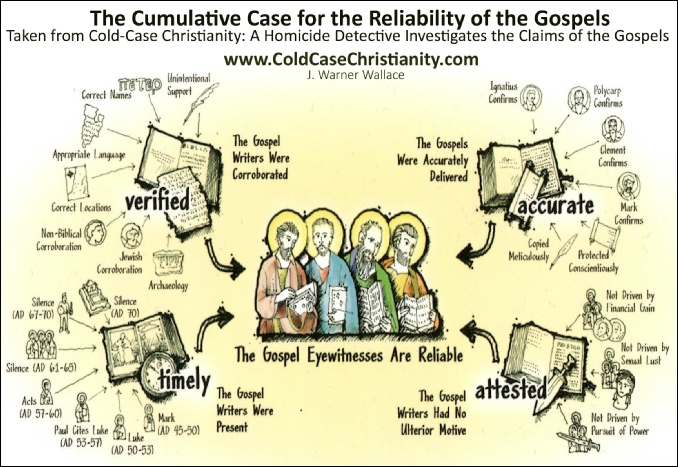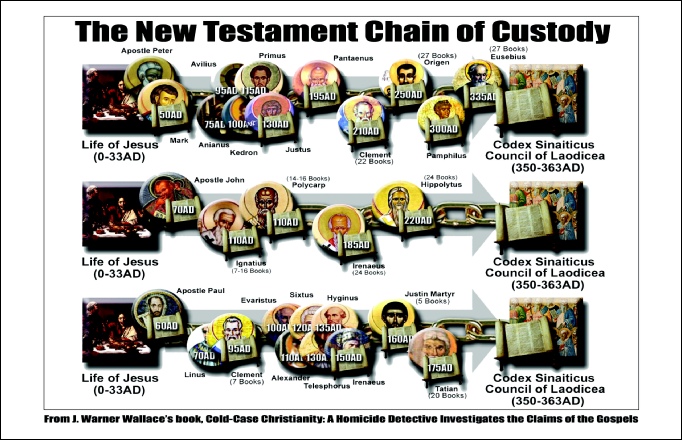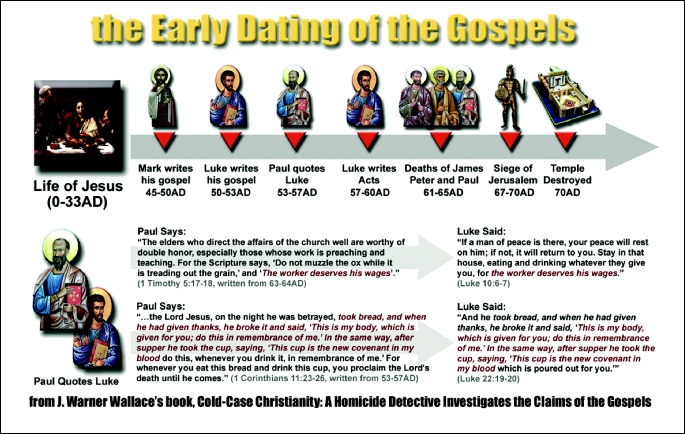


Is there Evidence for Jesus?
MAN? MYTH? MADMAN? MANIPULATOR? MESSIAH?
© David Bedford 2018.



The Case for the Reliability of The New Testament
Can we trust the New Testament? If we can’t then we have little foundation for our faith. However, if it is proven to be reliable, then we can have complete trust in our Faith and what we believe about who Jesus was - and is!
I am again indebted to J. Warner Wallace for his incredible research, and with his permission, I am reproducing his notes and illustrations. David Bedford
The case for the reliability of the New Testament Gospel eyewitness accounts is dependent on the reliability of the authors. Eyewitnesses are typically evaluated in criminal trials by asking four critical questions: Were the witnesses really present at the time of the crime? Can the witnesses’ accounts be corroborated in some way? Have the witnesses changed their story over time? Do the witnesses have biases causing them to lie, exaggerate or misinterpret what was seen? We can examine the Gospels and their authors by asking similar questions. Is the Bible true? The cumulative case for the trustworthy nature of the Gospels confirms their reliability:
(1) The Gospels Were Written Early - after Paul’s letters
The New Testament is not in chronological order.
It’s much harder to tell an elaborate lie in the same generation as those who witnessed the truth. The Gospels were written early enough to have been cross-checked by those who were still alive and would have known better:
(a) The missing information in the Book of Acts (i.e. the destruction of the Temple, the siege of Jerusalem, the deaths of Peter, Paul and James) is best explained by dating Acts prior to 61AD
(b) Luke wrote his Gospel prior to the Book of Acts
(c) Paul’s referencing of Luke 10:6-7 (1 Timothy 5:17-18, written in 63-64AD) and Luke 22:19-20 (1 Corinthians 11:23-26, written in 53-57AD) is best explained by dating the Gospel of Luke prior to 53-57AD
(d) Luke’s reference to his Gospel as “orderly” in Luke 1:3 (as compared to Bishop Papias’ 1st Century description of Mark’s account as “not, indeed, in order”) and Luke’s repeated references of Mark’s Gospels are best explained by dating Mark’s Gospel prior to Luke’s from 45-50AD. Matthew will therefore be from around the 50s AD, with John being the latest, possibly in the 90sAD.
(2) The Gospels Have Been Corroborated
The Gospel accounts of the first century are better corroborated than any other ancient historical account:
(a) Archaeology corroborates many people, locations and events described in the Gospels
(b) Ancient Jewish, Greek and Pagan accounts corroborate the outline of Jesus’ identity, life, death and resurrection
(c) The Gospel authors correctly identify minor, local geographic features and cities in the region of the accounts
(d) The Gospel authors correctly cite the ancient proper names used by people in the region of the accounts
(e) Mark’s repeated reference and familiarity with Peter corroborates Papias’ description of Mark’s authorship of the account
(f) The authors of the Gospels support one another unintentionally with details obscure details between the accounts
(3) The Gospels Have Been Accurately Delivered
The Gospels were cherished and treated as Scripture from the earliest of times. We can test their content and accurate transmission:
(a) A New Testament “Chain of Custody” can be reconstructed from the Gospel authors (through their subsequent students) to confirm the original content of the documents
(b) Much of the Gospels (and all the critical features of Jesus) can be confirmed in the writings of the Church Fathers
(c) The vast number of ancient copies of the Gospels can be compared to one another to identify and eliminate late additions and copyist variants within the text
(d) The earliest caretakers of the text considered it to be a precise, divinely inspired document worthy of careful preservation
(4) The Gospels Authors Were Unbiased
The authors of the Gospels claimed to be eyewitnesses who were transformed by what they observed in Jesus of Nazareth:
(a) The authors were convinced on the basis of observation afterward, rather than biased beforehand
(b) The three motives driving bias were absent in the lives of the authors. They were not driven by financial gain, sexual (or relational) lust or the pursuit of power. They died without any of these advantages
(c) The testimony of the authors was attested by their willingness to die for what they claimed. There is no evidence any of them ever recanted their testimony
The gospel authors were present during the life of Jesus and wrote their accounts early enough to be cross-checked by those who knew Jesus.
The gospel authors were present during the life of Jesus and wrote their accounts early enough to be cross-checked by those who knew Jesus. Their accounts can be sufficiently corroborated and have been accurately delivered to us through the centuries.
The authors lacked motive to lie to us about their observations and died rather than recant their testimony. Who dies for a lie that they know for a fact is a lie? They were eyewitnesses.
Is the Bible true? The case for the reliability of the Gospels is strong and substantive. We have good reason to trust what the eyewitnesses told us about Jesus of Nazareth.


